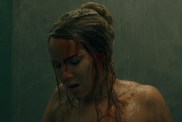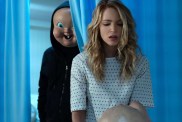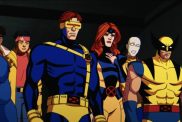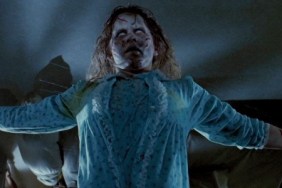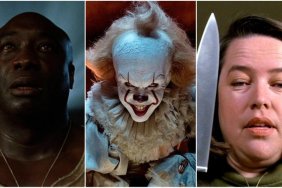
SHOCK examines 10 amazing horror novels that were (often controversially) adapted to film.
This debate always occurs among rabid horror literature and film enthusiasts: the merits of the original source material vs the eventual cinematic incarnation. Usually each side has valid points to make.
SHOCK takes a moment to reflect on some classic horror examples, beloved books that have been controversially adapted to the screen. The debate is often a sensitive spot for many and always worth discussion.
Enjoy…

THE AMITYVILLE HORROR by Jay Anson, film adaptation directed by Stuart Rosenberg (1979) and Andrew Douglas (2005):
A less controversial entry, because the source material and films are similar to one another. The 2005 remake is probably a more faithful translation than the original but it is not necessarily a better flick. The most significant difference between the movies and the book is Jodie and her appearance to other characters; primarily to the Lutzs’ daughter. Variously, she appears as a pig or angel or ghost of the murdered daughter of he house’s original owners and both versions of the film deal with it differently. Another glaring difference is the red room discovered in the basement, which is depicted differently as between the book and the two films.

GHOST STORY by Peter Straub, film adaptation directed by John Irvin (1981):
Not the most warmly received film in 1981 as many folks preferred the novel to the film, while some said the radically simplified film vastly improved on Straub’s haunting tale. One of the most radical distinctions is Alma/Eva, the film’s vengeful specter vs. the book’s Eva, who is more of a shape-shifting entity. Additionally, the endings are almost completely different from one another: the movie sees the vengeful Alma spilling out of her sunken car and getting some spiritual resolution, whereas the book has Eva coming back reincarnated to complete her fatal retribution on those who have done her wrong.

RED DRAGON by Thomas Harris, film adaptions directed by Michael Mann (MANHUNTER, 1986) & Brett Ratner (2002):
Though Mann’s MANHUNTER is moody and creepy, it really feels as if the director never bothered to read the book and his adaptation reflects that. Having said that, RED DRAGON by Ratner is a word for word translation from book to screen, but lacks any kind of menacing, nail-biting pulse and although faithful to the book, somehow feels empty (even with all the incredible talent, especially Ralph Fiennes as Francis Dolarhyde and Anthony Hopkins, returning from SILENCE OF THE LAMBS and HANNIBAL as Dr. Lecter)

THE EXORCIST by William Peter Blatty, film adaptation directed by William Friedkin (1973):
No real extreme controversy here by any means, but there are some major differences of opinion on Blatty’s and Friedkin’s distinctive takes on the tale. Blatty always intended the book to be more of a theological detective novel with a bleak backdrop and Friedkin instead delivered an intense supernatural horror that still resonates with millions. Blatty did reconcile himself to the divergence, and even delivered a follow up novel called LEGION which he directed when it was brought to the screen as THE EXORCIST III, thus burying any qualms he may have had with THE EXORCIST not being gumshoe-ish enough.

THE HUNGER by Whitley Strieber, film adaptation by Tony Scott (1983):
The film is loved by many, and Tony Scott’s stylistic Gothic thriller will be forever remembered for its noirish intro with Bauhaus/Peter Murphy performing “Bela Lugosi’s Dead” while David Bowie and Catherine Deneuve stalk their next meal…totally legendary. Strieber’s central plot focuses more on the ancient Egyptian vampire named Miriam Blaylock who can never rid herself of past lovers who eventually age but don’t actually die. All of Miriam’s lovers just wither away in specialized coffins. The film essentially eschews the novel’s plot in favor of style, and only hints at Strieber’s concept, a significant difference that rubs fans of the novel the wrong way.

FALLEN ANGEL by William Hjortsberg, film adaptation directed by Alan Parker (ANGEL HEART, 1987):
Even though ANGEL HEART is a celluloid masterpiece, author Hjortsberg had some beefs with Parker’s end result. Hjortsberg enjoyed the film (this writer had a one on one interview with the author for a feature in FANGORIA) tremendously but was not keen on some obvious stylistic liberties Parker took. Major changes like the film being set mostly in New Orleans instead of New York. Harry Angel being a dirty, stubbly pretty boy like Rourke instead of the cleaner-cut, semi-respectable character in the book. The movie also focuses more on voodoo as opposed to more straightforward black magic as described by Hjortsberg, however, both incarnations are masterpieces.

THE SPACE VAMPIRES by Colin Wilson, film adaptation by Tobe Hooper (LIFEFORCE, 1985):
Without saying one source is better than the other, there were some liberties taken in Hooper’s adaptation, for better or worse. The novel plays out more like heady science fiction, whereas the film has a distinct pulp sci-fi horror hybrid feeling to it, like ALIEN (makes sense since Dan O’Bannon co-wrote the screenplays for both). One of the major differences between the source and the film are the creatures themselves; in the book they are dimensional-travelling creatures that feed on human energy and in the film they rely more on traditional Vampire mythology, with the vampires being dispatched via stakes through the heart, or, in this case, just below the heart.( But the film has something Wilson’s novel does not: an awesomely nude Mathilda May! The film wins! -ed).

THE KEEP by F. Paul Wilson, film adaptation directed by Michael Mann (1983):
Here is an infamous and classical example of how things can really change from book to screen. F. Paul Wilson saw radical changes occur to his beloved book of the same title. Michael Mann’s cinematic take is something of an enigma; like our earlier Mann entry, it often feels like he’s only read the dust jacket blurb and not the book itself. Although don’t get me wrong, I loved the film for its stylistic dreaminess and surreal snail-speed horror. It feels like being trapped in a beautiful nightmare. Mostly, the fans of the book loathed the changes to the title antagonist from ancient vampire to a bizarre, red-eyed smoke demon/golem.

AMERICAN PSYCHO by Bret Easton Ellis, film adaptation directed by Mary Harron (1990):
Even though the film was loved by so many (Christian Bale completely nails it as Patrick Bateman), some fans of the novel were up in arms about the exclusion of the book’s most controversial murder sequences, which were essentially too much for the screen. Others were put off by the sterilization of the Bateman character. Like many talented directors, Mary Harron captures the essence of the written page as opposed to engaging in a literal regurgitation; this approach often works better for film.

THE SHINING by Stephen King, film adaptations by Stanley Kubrick (1980) and Mick Garris (1997) for television:
This adaptation clinches our top spot, this is by far the granddaddy of all controversies. Stephen King’s dislike for Kubrick’s interpretative take on his beloved book is epic and openly public. King hated it so much that he eventually commissioned a television mini-series remake that ultimately paled in comparison to its cinematic predecessor. In fairness to Garris, King wanted and obtained a literal translation of his material and unfortunately that’s why the show mostly fails. Kubrick captured the essence of the book so effectively; feelings of isolation, cabin fever and dread, all the while being intensely haunting and creepy. Most of the book’s factual details seem unimportant after watching Kubrick’s classic; like whether the hotel blew up at the end or not, or whether the hedges came to life vs a haunted maze…
Tell us some of your thoughts; anything we missed that should have been on this list?
